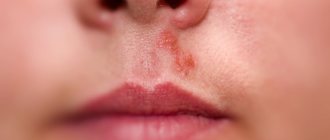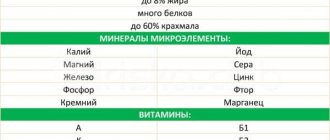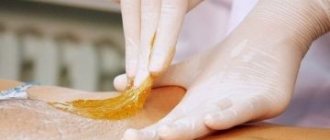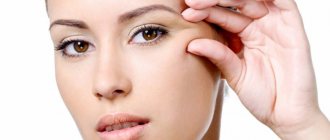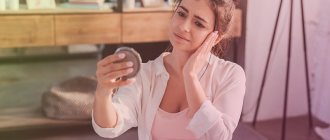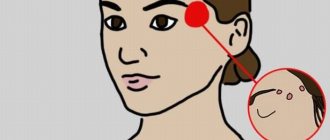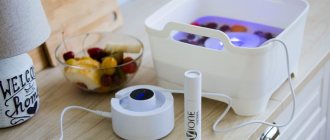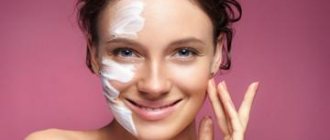You've probably noticed that pimples, blackheads, blackheads, inflamed areas and other troubles on the face most often appear on the skin of the forehead, nose and closer to the middle part of the chin. There is a T-shaped zone there, which causes many problems. But why does the skin behave this way there and, most importantly, how to tame it.
In this article:
Why does the T-zone get acne? Why do problems in the T-zone intensify? How to care for skin in the T-zoneCosmetology treatments for the T-zoneHome remedies for the T-zone
Where is the T zone on the face?
Photo: Social networks
Zone-t is the forehead, nose and chin. If you draw a line on the forehead, and then from the center of the forehead draw a line along the nose to the chin, you will get a clear letter T.
This is our problem area - the face. This is where some strange pimples, blackheads, and flaking of the skin most often occur. According to statistics, 90% of facial skin problems occur in this area.
Causes of T-zone problems
With dry and normal skin, there are no problems or difficulties in caring for the skin of the T-zone. But if your skin type is oily or combination, zone T really causes a lot of inconvenience.
It is in the T zone that the activity of the sebaceous glands, which produce excess sebum, is increased. Excess sebum is the main cause of pimples, blackheads, and redness. The problem area is enlarged and contaminated pores, an accumulation of “blackheads”.
The T-zone is a special place where the skin requires a different approach to daily care.
How to care for the zone
There is an unspoken rule among cosmetologists that says that healthy skin is, first of all, clean skin. Any skin care should begin with cleansing it of dust and dirt.
The skin in the T-zone is relatively rough and covered with a sebaceous coating, so using plain water cannot achieve high-quality cleansing of the skin. It is best to use neutral toilet soap or gel for washing.
If the skin reacts poorly to soap or other cosmetics, you can use simple kefir or whey to wash your face.
✔ Fermented milk products have a unique ability to increase the acid barrier of the skin. After cleansing the skin with kefir or whey, microbes stop spreading.
✔ In the morning, apply kefir to the zone-t using a cotton pad, leave for five minutes, then rinse with warm water.
✔ Daily washing with vinegar water does a good job of removing excess sebum and increasing skin acidity. To prepare the solution, add one tablespoon of vinegar to one liter of water. You can simply wash your face with this water, or you can soak a cotton swab in it and wipe problem areas: forehead, bridge of the nose, wings of the nose, chin.
Of course, washing alone is not enough for complete care. Zone T is quite capricious and, unfortunately, a universal cosmetic product for its care has not yet been produced. But home care remedies are quite enough.
Mistakes of plastic surgeons. why I don’t recommend a vertical lift.
Many foreign (and after them some domestic) plastic surgeons have recently preferred a tension vector directed vertically upward. However, the use of this technique often leads to a catastrophic change in facial features, not to mention the fact that such a lift does not give the desired result in the neck area. But it is the neck and lower third of the face that are one of the main areas requiring correction.
Distortions after a vertical lift are especially characteristic of high-cheekboned, typically Slavic faces. The result is a characteristic deformation - the so-called “Mordovian face” (I apologize in advance to representatives of this nationality). With such deformities, it is impossible to achieve a natural plastic result even with perfectly executed and completely invisible scars.
Home remedies for deep skin cleansing
At home, peelings, scrubs and clay masks can be used to deep cleanse the T-zone.
Skin peeling
Before starting these home treatments, you need to wipe your face with a cosmetic tonic, then you need to steam the skin with a hot towel.
As soon as the skin has steamed and the skin pores become elastic, apply a face peeling cream or scrub to the area with a cotton pad. Give a short massage and rinse off the cleanser with cool water.
Deep cleansing with clay
Dilute one teaspoon of cosmetic clay with a few drops of water to a thick mass. Add a little lemon juice and a few drops of vodka. Mix the mass well.
Apply the resulting mixture to the area with a cotton pad and leave for 20 minutes. Then rinse with warm water.
Zone-t responds well to deep cleansing, but these procedures can be considered aggressive on the skin. Therefore, deep cleansing of the T-zone should be performed no more than once or twice a week.
Incisions in the scalp
Today, lifting the midface, eyes and eyelids can be performed using a variety of surgical techniques. Often, surgeons use access through the lower eyelids in mid-zone plastic surgery.
However, endoscopic technology occupies a leading place among other methods - it is the most convenient, modern and least traumatic for the patient. In addition, when used, there are practically no traces of surgical intervention.
During an endoscopy, the doctor makes tiny incisions in the part of the head that is covered by hair. An endoscope, a thin metal tube with a camera at the end, is inserted through the incisions under the tissue.
The image is displayed on the computer monitor. Thanks to this, this technique allows surgeons to see what is happening from the inside.
The surgeon’s goal is to move the facial tissues and fat layer higher, to lift them, as they are relaxed and stretched over time. To do this, the doctor uses very thin, blunt instruments to lift and peel away the tissue under the skin. As a result of these manipulations, a thin tunnel is created in the middle zone of the face, which allows you to tighten the sagging tissue from the inside.
Tips for caring for the area
Photo: Pixabay
✔ Steam baths with infusions of medicinal herbs, such as chamomile, are very useful. Steam expands the pores and they are freed from dust, dirt, and excess sebum.
✔ Our skin loves both warmth and cold, it needs them equally. To narrow the pores of the skin, it is useful to wipe the area with pieces of ice several times a week before going to bed.
✔ Use drying and antibacterial lotions and tonics with zinc oxide or salicylic acid for daily care.
✔ 10 minutes before washing it is useful to wipe the area with cabbage juice.
✔ Pamper your facial skin with toning treatments several times a week and the problem area will thank you. Add the juice of one aloe leaf to a glass of mineral water and stir. Wipe with this product not only the t-zone, but also your cheeks and neck. This is a very good product for any skin type.
✔ Never squeeze pimples. A squeezed pimple will not go away and the inflammation will only drag on. A simple infusion of orange and tangerine peel will help fight acne in the T-zone. Brew some citrus peels with boiling water and let it brew. The infusion can be used for washing in the morning and wiping inflamed areas of the skin. This infusion can even be used for lotions.
✔ If the T-zone is very oily, do not go to the solarium, these procedures will only harm you.
The secret of the invisible seam. Work requiring jewelry craftsmanship
In order for the seam to be vanishingly thin and completely unnoticeable after healing, it is necessary to ensure a uniform (ideally zero) load and remove any irritating effect.
Too much tissue tension is the main cause of scar stretching, which can make it wide and rough. So the surgeon should strive to keep stress on the sutures to a minimum.
I achieve this by securing the tissue in the hidden areas around and inside the ears using special interrupted sutures. Special unloading methods of fixation allow you to remove excess tension and provide effective unloading of the seams, allowing the formation of thin, invisible scars.
Editor's note: The development of this method of unloading tissue fixation is the merit of Ekaterina Sergeevna's colleague and teacher, a famous specialist in facial plastic surgery, Igor Aleksandrovich Wulf. However, Dr. Kudinova, thanks to her wealth of experience and many years of practice, was able to improve this technique by developing her own “invisible seam” technique.
It is important to note that in the process of removing excess skin and applying sutures, not only deep theoretical knowledge is needed, but also practical experience, as well as professional flair and taste. This cannot be taught, but with talent and great desire, it can be learned. Attempts to improve skin tightening must be balanced with measures to prevent excessive skin tension, which can even cause necrosis of the peripheral areas of the flap.
When unloading sutures are applied, you can begin suturing the incisions. In this case, each area has its own methodology. For the hair growth area on the head, I use a wrap stitch. This stage requires purely feminine patience and accuracy. The stitches must be performed extremely evenly, achieving strictly the same tension along the entire length of the hem. This allows for uniform loading and ensures the safety of the hair follicles around the incision.
In this case, I do not use interrupted sutures, since bedsores form under them, leading to damage to the hair roots and the formation of bald areas. Naturally, in aesthetic surgery such side effects should be completely excluded! For the same reasons, I refused to use an intradermal suture for the scalp.
To obtain an “invisibility effect,” the removal of sutures in the tragus area is performed already on the 2-3rd day after surgery. In the scalp, fixing threads are removed only after 14 days from the date of surgery, because they perform the function of unloading the seams, which are located on open areas of the face (at the border of the cheek and ear). Thanks to this tactic, all postoperative scars (especially scars in open areas) are thin and invisible.
Daily care lotion
You can prepare your own rescue lotion for the T-zone; to prepare it you will need benzoic acid, menthol, camphor alcohol, chamomile, sage, vodka and food grade acetic acid.
Dissolve 2 ml of benzoic acid, 0.25 grams of menthol in 30 ml of camphor alcohol. Add 2 tablespoons of chamomile or sage flowers, a glass of vodka, 200 ml of water and 5 ml of acetic acid. Mix the ingredients.
Use the lotion twice a day to wipe problem areas of the skin. The lotion should be stored in the refrigerator.
Masks for zone-t
Photo: Pixabay
Zona-t responds well to additional care. Masks can be performed once or twice a week. Before the procedure, the skin of the face must be cleansed with toner so that dirt is not absorbed into the skin along with the beneficial ingredients of the mask. The mask should not be applied to the eye area.
Tea mask
Mix one teaspoon of dry green tea, 4 drops of tea tree essential oil. Close the container and leave for a day. Then pour a glass of boiling water over the mixture and strain after 40 minutes. Add one tablespoon of lemon juice and ground rolled oats to the infusion until a thick mixture is formed. Apply the mask for 20 minutes, rinse with tea.
Egg mask
✔ Beat one egg white, add ground rolled oats and 3 drops of tea tree essential oil. Apply the mask to your face, wait until it dries and rinse with cool water.
✔ Grate one apple, add whipped egg white. Apply the mask to your face, leave for 15 minutes, then rinse with warm water.
✔ Soften strawberries or wild strawberries, add whipped egg white. Apply the mask to your face in several layers. After 15 minutes, rinse with cool water.
✔ Beat 1 egg white, add one teaspoon of cranberry juice and one teaspoon of starch. Apply the mask on your face for 15 minutes, rinse with warm water.
Kefir mask
Grind 5 tablespoons of green tea and add 3 tablespoons of kefir. Mix the mixture and apply to your face. Rinse off after 15 minutes with warm water.
Honey mask
Mix 1 teaspoon each of honey, potato starch, warm milk and salt. Apply the mixture in several layers, rinse with warm water after 25 minutes. Then rinse with cool water and lemon juice.
Cucumber mask
Grate the cucumber, add boric acid. Apply the mixture to your face and leave for 15 minutes. Then rinse with warm water.
Creamy mask
Steam your face first. Grind the plum fruits and add rolled oats flour. Apply the resulting paste in a thick layer to the skin of the face and neck. Leave the mask on for 15 minutes, rinse with warm water.
The T-zone will no longer be a problem if you take care of it especially carefully. There is no skin problem that cannot be dealt with.
If home remedies do not give a positive effect, then something is being done incorrectly. A consultation with a cosmetologist will help you find out and understand skin problems, and traditional medicine recipes will never be superfluous.
Borzokh Olga Borisovna
Candidate of Medical Sciences, dermatovenerologist, cosmetologist, researcher at the Center for Collective Use "Molecular and Cellular Technologies" of Krasnoyarsk State Medical University, Country Expert Teoxane Russia, Voronezh
The periorbital area continues to be the focus of attention of cosmetologists, since, on the one hand, this is one of the most popular requests from patients, and on the other hand, many unresolved questions remain regarding the choice of techniques or drugs. In this article, I propose to somewhat expand the focus of our attention and discuss the correction of not only the infraorbital sulcus, but also other areas around the eyes - the temporal region, the forehead, the middle third, since all these zones can influence the aging process in the periorbital region [1] .
But first of all, you need to understand what the goal of aesthetic correction is when working with age-related changes. The goal of most patients is to correct age-related manifestations, but without traces of intervention, while the most common concerns of patients are unnatural results, contouring of the drug, and swelling in the periorbital area. In my opinion, it is possible to help achieve a better result and natural correction by choosing the right indications and technique for performing the procedure, based on the Teoxane approach.
The Teoxane approach was developed to achieve the most effective and natural-looking aesthetic treatment results while maintaining the safety of injection procedures. When working with the Teoxane approach, we always follow the three Ps (A-T-P) - anatomy (including assessment of the aging process and patient indications), technique and drug selection.
Anatomy
One article or even one book is not enough for the anatomical features of the area around the eyes, so I propose to dwell only on some of the anatomical aspects necessary for work.
Speaking about the area under the eyes, first of all it is necessary to understand the features of the layer-by-layer structure of the zone of the lower edge of the orbit (Fig. 1) [2].
- 1st layer - skin : in the periorbital area it is thin due to a decrease in the number of layers of the epidermis and thinning of the dermis itself;
- 2nd layer - subcutaneous fat : thin, often in Caucasian patients it can be practically absent in the area of the medial corner of the eye;
- 3rd layer - orbicularis oculi muscle : attached to the bony edge of the orbit with the help of the orbicularis oculi ligament (ORL), while its attachment is stronger in the medial corner of the eye, resulting in the formation of the tear groove;
- 4th layer - layer of deep fat pads : presented mainly lateral to the medial canthus of the eye in the form of a deep infraorbital fat pad (SOOF);
- 5th layer - periosteum.
When working in this area, the following are distinguished (Fig. 2) [3]:
- palpebral wrinkles (wrinkles on the skin of the eyelid);
- tear trough - a line of depression running from the medial edge of the eye down to the midpupillary line;
- palpebromalar groove - a lateral continuation of the lacrimal groove;
- midbuccal groove - continuation of the lacrimal groove downwards;
- nasolabial fold - in the middle third.
In the supraorbital region, the five-layer structure is preserved, but, unlike the infraorbital region, the skin is thicker, the subcutaneous fat is full, the deep fat pack is represented by the supraorbital fat pack (ROOF) (Fig. 3) [4].
The temporal region is an area where many questions remain regarding the anatomical structure. Regarding the number of layers of tissue in this area, most experts believe that 10 layers can be distinguished in it.
It is more important in this area to designate safer zones and caution zones (Fig. 4) [5]. Thus, a safer compartment is the superior temporal compartment (UTC), located between the temporal crest (superior temporal septum - STS) and the inferior temporal septum (ITS), in the inferior temporal compartment (LTS) blood vessels and nerves are located.
In the forehead area there are also 5 layers of soft tissues of the face (Fig. 5) [6]: skin, subcutaneous fat, SMAS (represented by the frontal muscle, or aponeurosis), a layer of deep fat packets and periosteum.
A safer level is the layer of deep fatty packets under the SMAS; the main vessels above the safety line (it runs 2 cm above the bony edge of the orbit) are in the superficial fatty layer, below the line - in the deep.
In the area of the midbuccal groove, five layers are also preserved: skin, superficial and deep fat packets, SMAS, periosteum [7–9]. The main level when working with volumizers is the level of deep fat packs (medial deep infraorbital fat pack and deep medial zygomatic fat pack); with pronounced age-related changes, the goal of correction is also the superficial medial fat pack.
In addition to anatomy, the first point of the Teoxane approach involves understanding the aging process in different layers:
- the skin becomes thinner, fibroblasts reduce their synthetic activity, the skin becomes overstretched and its elasticity decreases;
- in subcutaneous fatty tissue and deep fatty tissues, a decrease in fatty tissue and redistribution of fat occurs - a change in the ratio of different fatty tissues;
- muscles, as a rule, undergo atrophy, the ligamentous apparatus stretches and loses its strength;
- the periosteum (or rather, the bone) also undergoes resorption.
As a result of all these processes, we see volume deficits in the upper and middle third of the face, as well as ptosis of the eyebrows, upper eyelid, and the appearance of furrows in the infraorbital region, which appear as a result of loss of support from overlying structures.
Thus, there is a connection between volume deficits and ptosis of certain structures; therefore, replenishment of lost volume will reduce the manifestations of ptosis.
Last but not least, what we look at with the Teoxane approach in point one is patient assessment. In fact, correctly determined indications made on the basis of complaints and examination of the patient are of great importance on the path to ideal aesthetic correction of the periorbital region.
At the same time, it is important that the patient himself points out the areas that he does not like about himself, since each person has his own ideas about beauty, and areas in the patient that are incorrectly identified and corrected by the doctor can give an unsatisfactory result after the procedure. If our patient cannot decide on areas of concern to him, you can give him a mirror and “introduce him to yourself.”
Selection of equipment
The next point in Teoxane's approach is technique. This paragraph assumes the plural because, in our opinion, there is no one correct correction technique - we use our own, using a needle or cannula, but these techniques must “respect” the anatomy in terms of safety and effectiveness. To do this, on the face we highlight areas of increased attention, safety lines, and areas with a lack of volume (Fig. 6).
When working with the upper and middle third of the face, we must remember the location of the angular artery (in the inner corner of the eye), the exit of the infraorbital and supraorbital neurovascular bundles (along the midpupillary line), supratrochlear (1 cm medial to the supraorbital), zygomatic (1 cm below the lateral bony edge of the orbit), the location of the transverse artery (along the lower edge of the zygomatic arch) and the temporal vessels (most often visualized on the patient’s face).
Of the safety lines, we are interested in the midbuccal line and the line in the projection of the zygomatic major muscle - it is safer to work in the superolateral quadrant when these lines intersect. In the temporal region, the safety line runs between the tragus and the lateral edge of the orbit - it delimits the superior temporal compartment. In the forehead area, the safety line is 2 cm above the bony edge of the orbit.
When augmenting the forehead area, we may use a cannula or a needle. The drug is administered at the SMAS; before the procedure, it is important to note areas of volume deficiency, and when working with a cannula, the injection points are determined (between visible vessels) (Fig. 7). When working with a cannula, you can use one (for a more flattened forehead area) or 2 injection points (for a more rounded one); a 25G cannula is safer; a 22G cannula has a smaller diameter and is closer in sharpness to a needle. The drug is distributed fan-wise using a retrograde technique. The SMAS zone requires a distributed, dynamic drug with average G' values; we will talk about the choice of drug in the next paragraph.
To lift the eyebrow, an injection point is used, located under the eyebrow, lateral to the midpupillary line. The drug is located supraniosteally, in the region of the deep supraorbital fat pad (ROOF) (Fig. 8). Typically, when performing this technique, I raise the eyebrow and use a small bolus of drug (0.2 ml) with a high G'.
When working with the temporal region, it is safer to administer the drug deeply (under the temporalis muscle) in the superior temporal compartment. The injection point for the shot gun technique is 1 cm below the temporal crest and 1 cm above the lateral bony rim of the orbit (Fig. 9). The procedure is carried out with a needle, safer 25 mm long (a shorter needle may not be completely on the bone). The injection is made between visible vessels until it touches the bone, then the needle must be tilted so that the needle hole is as close as possible to the bone. The drug will be distributed between the fibers of the temporal muscle, since the muscle is firmly attached to the bone and there is no space under it. Due to the location of the drug, a drug with maximum G' and cohesiveness is required.
When working with infraorbital grooves, injections are carried out strictly in the area of volume deficiency; in the case of working with a cannula, you can select one injection point between the lacrimal and palpebromalar grooves, bypassing the projection of the infraorbital foramen (Fig. 10A, B). When working with a cannula, it is safer to choose larger diameter cannulas (25G, 22G). The drug is administered under the orbicularis oculi muscle. Considering the complex and delicate anatomical structure of the infraorbital region, you should carefully select the drug based on its viscoelastic properties.
When correcting the midbuccal sulcus, the volume of zygomatic fat pads is corrected, but there may be a difference in the technique in patients of the older and middle age groups.
In patients of the middle age group, in young people, with initial manifestations of volume deficiency in the area of the midbuccal sulcus in the pathogenesis of age-related changes, as a rule, only deep fatty packets are involved, therefore, in them, the introduction of a volumizer is carried out only at the level of the medial infraorbital fatty packet or at the level of the deep medial fat pack.
In older patients, volume loss occurs at the level of the superficial medial fat pad, therefore, for a full result, a multilayer technique for correcting the middle third is necessary, as we mentioned in the article [10].
When working with a needle, boluses of the drug are located supraniosteally, lateral and above the safety lines. When working with a cannula, the injection point is located lateral to the midbuccal line and the cannula passes at the level of deep fatty bags. For convenience, you can lift the tissues with your second hand and pass under them in the area of the medial infraorbital fat pad and the medial deep zygomatic fat pad (Fig. 11).
Choice of drug
Sometimes the choice of drug is not given due attention, as a result, the risks of an unnatural correction result, low effectiveness of the correction, contouring and swelling, especially in the periorbital area, increase. It is important to understand that each zone and each tissue layer may require different viscoelastic properties of the drugs. We have already spoken about the rheological properties of drugs quite a large number of times [11, 12]. Let's take a closer look at the choice of drugs based on the anatomical features of each area.
When augmenting the forehead, the space under the SMAS is quite small, there is not a large amount of tissue above it, so the pressure exerted on the injected drug is relatively low, but at the same time the zone is mimically active (movable), so an elastic drug is required, with an average G' index, capable of stretching . Teosyal® RHA2 and Teosyal® RHA3 have these properties (Table 1). Teosyal® RHA is a collection of dynamic fillers that are stretchable and, as a result, maximally adapted to the dynamics of the face. When using them, we obtain maximum efficiency in the area of administration with maximum naturalness of the result. For thinner skin, thin soft tissues and a slight lack of volume, the most suitable drug is Teosyal® RHA2, for greater thickness and the need for volume - Teosyal® RHA3. In my practice, I sometimes use Teosyal® RHA4, but only in cases of large thickness of soft tissues and pronounced loss of volume in the forehead area, when greater volumizing abilities of the drug are needed while maintaining its elastic properties. In this case, the drug should be administered as delicately as possible, avoiding overcorrection.
Table 1. Comparative characteristics of Teosyal® RHA2 and Teosyal® RHA3
| Teosyal® RHA2 _ | Teosyal® RHA3 _ | |
| Compound | Reticulated HA 23 mg/ml | Reticulated HA 23 mg/ml |
| Degree of modification (MoD) | 3,1% | 3,6% |
| Rheological properties | High tensile strength Moderate compression force | Good tensile strength High compression force |
| Indications | Moderate dynamic wrinkles and lip correction | Moderate dynamic wrinkles and lip correction |
When working with the area of the infraorbital grooves, you should choose the drug especially carefully. The anatomical features of the zone dictate the need for a lightly distributed drug (to prevent compression of the lymphatic drainage) (reducing the risk of contouring in an area with a deficiency of fatty tissue) with low residual hygroscopicity. Such a drug is Teosyal® Redensity 2 (Table 2). Teosyal® Redensity 2 was developed specifically for the correction of this delicate area, it has low residual hygroscopicity and is a light, spreadable hyaluronic acid gel. Moreover, it has official indications - correction of infraorbital grooves.
Table 2. Characteristics of the drug Teosyal® Redensity 2
| Teosyal® Redensity 2 | |
| Compound | Reticulated HA 15 mg/ml |
| Degree of modification (MoD) | 5,5% |
| Rheological properties | Good distribution, plasticity, low hygroscopicity |
| Indications | Correction of the lacrimal and palpebromalar grooves |
| Insertion depth | Under the orbicularis oculi muscle |
I have already mentioned the need to use a drug with the highest G' and the highest possible cohesiveness when augmenting the temporal region due to the location of the gel along the muscle fibers of the temporal muscle. Such drugs are Teosyal® RHA4 and Teosyal® Puresense Ultra Deep (Table 3). I generally prefer Teosyal® RHA4 for younger patients and Teosyal® Puresense Ultra Deep for older patients. Both drugs contain 0.3% lidocaine, which is extremely important when working in the area of the temporal fossa.
Table 3. Comparative characteristics of Teosyal® Puresense Ultra Deep and Teosyal® RHA4 volumizers
| Teosyal® Puresense Ultra Deep | Teosyal® RHA4 _ | |
| Compound | Reticulated HA 25 mg/ml | Reticulated HA 23 mg/ml |
| Degree of modification (MoD) | 10,0% | 4,0% |
| Rheological properties | Very high cohesiveness High elasticity | High tensile strength Very high compression force |
| Indications | Insufficient volume in a limited area: cheekbones, chin, etc. | Insufficient volume in the tensile or dynamic area: cheeks, facial contour, etc. |
| Insertion depth | Deep fat pads (nanoperiosteal) | Superficial and deep fat packets |
To carry out eyebrow lifting, I usually use the remainder (0.1–0.2 ml) of the volumizer that was used to correct the middle or upper third of the face.
And finally, when correcting the midbuccal groove, the most rational use of volumizers (see Table 3). When filling deep fat bags in older patients, patients with pronounced thickness of soft tissues, to create maximum projection, I prefer the classic rigid (that is, hard) Teosyal® Puresense Ultra Deep volumizer; it has a very high G', high cohesiveness, and maximum lifting ability. When using the multilayer technique - filling superficial fat bags with a pronounced deficiency in the area of the midbuccal groove, as well as when working with deep fat bags in patients with small thickness of soft tissues of the face, I prefer Teosyal® RHA4. Teosyal® RHA4 is a dynamic volumizer with a high G', high resistance to repetitive stress, but at the same time “respecting” facial expressions and giving the most natural correction.
Conclusion
When working with the area around the eyes, we most often choose complex techniques. The validity of the choice of complex techniques is confirmed by the peculiarities of the aging process in this area. Thus, by filling the deficit in the upper zones (such as the forehead, temporal region, eyebrow area), we restore support for the eyebrow and upper eyelid, and by restoring the middle third, we improve the results of correction of the infraorbital grooves (Fig. 12). In this example, the patient underwent augmentation of the forehead area (Teosyal® RHA4 - 1.0 ml on each side), augmentation of the temporal area (Teosyal® PS Ultra Deep - 0.4 ml each), eyebrow lifting (Teosyal® PS Ultra Deep - 0.2 ml each), correction of the midbuccal groove (Teosyal® PS Ultra Deep - 0.6 ml each) and filling of the lacrimal and palpebromalar grooves (Teosyal® Redensity 2 - 0.5 ml each). As a result, we made the face more harmonious in the ratio of the upper third to the middle and lower third, the patient looked less tired (by reducing the deficit of the middle third and the severity of the infraorbital grooves), the overhang of the eyelid decreased, and the shape of the forehead area and the deficit in the temporal region were corrected.
At the same time, in terms of complex treatment, one should not forget about restoring the quality of the skin. To fully restore the functional activity of fibroblasts, my favorite is Teosyal® Redensity 1, the results of which can be seen after the first procedure.
The article was published in the magazine “Cosmetics and Medicine Special Edition” No. 2/2021
As an advertisement
Literature
- Pessa JE An algorithm of facial aging: verification of Lambros's theory by three-dimensional stereolithography, with reference to the pathogenesis of midfacial aging, scleral show, and the lateral suborbital trough deformity. Plast Reconstr Surg 2000; 106(2): 479–488
- Vrcek I., Ozgur O., Nakra T. Infraorbital Dark Circles: A Review of the Pathogenesis, Evaluation and Treatment. J Cutan Aesthet Surg 2016; 9(2): 65–72.
- Lee JH, Hong G. Definitions of groove and hollowness of the infraorbital region and clinical treatment using soft-tissue filler. Arch Plast Surg 2018; 45(3): 214–221.
- Mustak H., Fiaschetti D., Gupta A., Goldberg R. Eyebrow Contouring with Hyaluronic Acid Gel Filler Injections. J Clin Aesthet Dermatol 2018; 11(2): 38–40.
- Huang R.L., Xie Y., Wang W., et al. Anatomical Study of Temporal Fat Compartments and its Clinical Application for Temporal Fat Grafting. Aesthet Surg J 2017; 37(8): 855–862.
- Peng JH, Peng PH HA Filler Injection and Skin Quality-Literature Minireview and Injection Techniques. Indian J Plast Surg 2020; 53(2): 198–206.
- Rohrich RJ, Pessa JE, Ristow B. The youthful cheek and the deep medial fat compartment. Plast Reconstr Surg 2008; 121(6): 2107–2112.
- Mendelson BC, Muzaffar AR, Adams WP Surgical anatomy of the midcheek and malar mounds. Plast Reconstr Surg 2002: 110(3): 885–896.
- Mendelson BC, Jacobson SR Surgical anatomy of the midcheek. Facial layers, spaces, and the mid cheek segments. Clin Plast Surg 2008; 35(3): 395–404.
- Borzykh O.B. Multi-layer technique for correction of the middle third of the face when working with the periorbital region: addition or necessity? Injection methods in cosmetology 2020; 4:20-27.
- Egorova M.L. A dynamic method of creating volume in the cheekbone area with hyaluronic fillers Teosyal Ultra Deep and Teosyal RHA. An ideal combination for maintaining the natural appearance of the face during its movements. Injection methods in cosmetology 2019; 4:32–38.
- Borzykh O.B. A combination of Teosyal Ultra Deep and Teosyal RHA4 volumizers to create a line of ideal profile. Injection methods in cosmetology 2020; 1:26–31.
